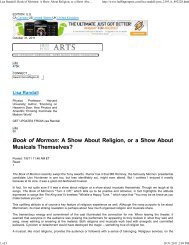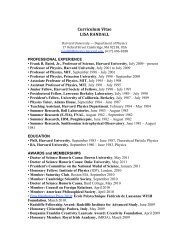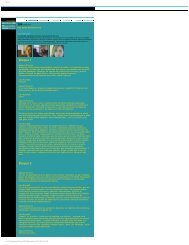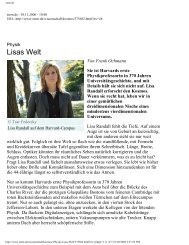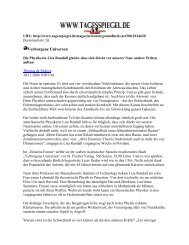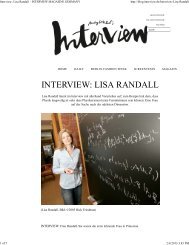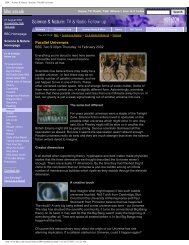BBC - Science & Nature - Horizon - Parallel Universes - Transcript
BBC - Science & Nature - Horizon - Parallel Universes - Transcript
BBC - Science & Nature - Horizon - Parallel Universes - Transcript
- No tags were found...
You also want an ePaper? Increase the reach of your titles
YUMPU automatically turns print PDFs into web optimized ePapers that Google loves.
<strong>BBC</strong> - <strong>Science</strong> & <strong>Nature</strong> - <strong>Horizon</strong> - <strong>Parallel</strong> <strong>Universes</strong> - <strong>Transcript</strong>NARRATOR: Now they had to explain how the collision of two parallel universescould go on to create these lumps of matter. Was there something about themembranes, or branes, which could explain it?NEIL TUROK: People tended to think of branes as being flat, perfect sheets,geometrical plains, but I think to us it was clear that that picture could not becorrect. It cannot be perfectly flat. It has to ripple.PAUL STEINHARDT: What would happen as these branes approach that there areripples in the surface of each brane and when they come together they don't hit atexactly the same time, same place, but in fact they hit at different points and atdifferent times.BURT OVRUT: We found that as the brane moves it literally ripples, so when thecollision takes place it imparts those ripples into real matter.NARRATOR: The parallel universes move through the eleventh dimension likewaves and like any wave these would ripple. It was the ripples which went on tocause the clumps of matter after the Big Bang. They finally had their completeexplanation of the birth of our Universe and now they could do something evenmore profound. They could take the laws of physics back in time to the moment ofthe Big Bang and through to the other side.NEIL TUROK: The existence of branes before the singularity implies there wastime before the Big Bang. Time could, can be followed through the initial singularity.BURT OVRUT: You sort of go back and back and back until you get near the placewhere the expansion would have taken place and then it just sort of changes intoanother world. When the branes collide the collision of those can be explainedwithin M Theory, so it just simply enters the realm of mathematics and science nowrather than being a, an unknown point that exploded.NARRATOR: The singularity had disappeared and it had taken them just under anhour.PAUL STEINHARDT: Then we went to see the play.NARRATOR: This idea is so new it's only begun to be discussed, but if it'saccepted it will mean Einstein's missing theory has finally been found. M Theorymay really be able to explain everything in the Universe, but the victory will bebittersweet, for at the end of its long quest, science has discovered that theUniverse it's thought to explain may be nothing special. It is nothing more than oneof an infinite number of membranes, just one of the many universes which make upthe multiverse.MICHIO KAKU: The latest understanding of the multiverse is that there could be aninfinite number of universes each with a different law of physics. Big Bangsprobably take place all the time. Our Universe co-exists with other membranes,other universes which are also in the process of expansion. Our Universe could bejust one bubble floating in an ocean of other bubbles.NARRATOR: But this isn't quite the end of the story. Now that the Theory ofEverything may have been found some are keen to use it. Physics is preparing forthe ultimate flight of fancy: to make a universe of its very own without anymysteries or unanswered questions at all.ALAN GUTH: I in fact have worked with several other people for some period oftime on the question of whether or not it's in principle possible to create a newhttp://www.bbc.co.uk/science/horizon/2001/parallelunitrans.shtml (10 of 11)8/27/2007 11:12:58 AM







